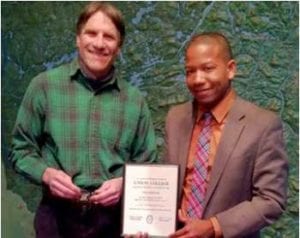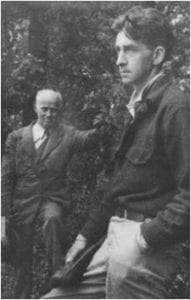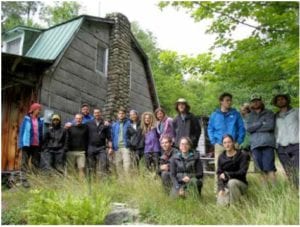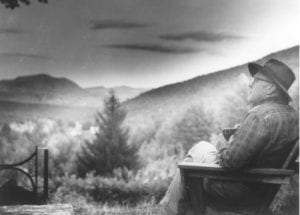Stewardship
BY DAVID GIBSON
April 2015 | Volume 21, Number 1
Adirondack and Catskill residents as well as the general public in both New York State (NYS) and around the nation are still celebrating the 50th anniversary of the Wilderness Act of 1964 and the 120th anniversary of the “forever wild” Article 14 of New York State’s constitution. The 109 million acres (44,110,735 ha) of the National Wilderness Preservation System (NWPS) has some of its origins traceable to decisions made by 19th- and 20th-century New Yorkers to place public lands in the Adirondack and Catskill Parks within the “forever wild” protection of the New York State Constitution. The Adirondacks, now 6 million acres (2,428,114 ha) in size and one-fifth of the state, significantly influenced wilderness preservation in America and was, in turn, influenced by the NWPS and other state wilderness programs.

David Gibson, left, with Eddie Summers, chief of staff at Union College, hold the honorary doctorate given to Paul Schaefer by Union College in 1979. The setting is the college’s Kelly Adirondack Center, formerly the home and library of New York wilderness conservationist Paul Schaefer. Photo by Ken Rimany.
New York State Forest Preserve
The mandate that public lands known as the forest preserve “shall be forever kept as wild forest lands” under the NYS Constitution (1894) caught the nation’s attention right from the start. Our constitutional mandate was influenced by the growing conservation movement that resulted in the creation of Yellowstone National Park in 1872 and a federal office of forestry just a few years later, but it was mostly influenced in New York by public impatience with the unchecked commercial exploitation of Adirondack forests and wildlife that had accelerated following the Civil War (Terrie 1994).
The New York State Forest Preserve was legislated in 1885 as public land whose principal purposes were to designate an area to consolidate its public forests, preserve a future timber supply, and maintain large Adirondack watersheds that fed the state’s system of canals – the main commercial transport system in the state (Brown 1985). The attempt to conserve forestland for present and future commerce and other laws enacted at the same time to regulate hunting were important conservation events, given widespread exploitation of natural resources at the time. The Forest Preserve statute of 1885 proved ineffective in stopping the overcutting, trespass, and loss of public forests to loggers and railroad barons. In 1894, a committee on forest preservation was formed by the New York Board of Trade and Transportation because they were concerned about the future of the state’s canals (Terrie 1994). Gaining influence with the leaders of that year’s New York Constitutional Convention, the committee was invited to draft an article that was introduced and passionately debated late that summer. Despite stiff last-minute opposition by timber and railroad interests, the constitutional article was passed by the convention and approved by the voters. The result was considered “ironclad” protection for the forest preserve. Only 54 words long, that article, now numbered Article 14, Section 1, remains in effect 120 years later. It is the only forest preservation measure embedded within any U.S. state constitution:
The lands of the state, now owned or hereafter acquired, constituting the forest preserve as now fixed by law, shall be forever kept as wild forest land. They shall not be leased, sold or exchanged, or be taken by any corporation, public or private, nor shall the timber thereon be sold, removed or destroyed.
At the time, many people thought that the constitutional mandate to preserve the forest would be temporary and that the need for and popularity of such restrictive mandates on timbering would retreat as “scientific forestry” advanced in the early 20th century (Terrie 1994). Yet New Yorkers were acutely aware of the uniqueness of this constitutional protection and were determined to maintain their hard-won forest safeguards, especially in view of what was happening across the United States and what appalled and motivated the late 19th-century conservation movement in the country – the loss of old-growth forests to commercial exploitation, extermination of wildlife predators, and loss of soil and siltation in rivers and tributaries.
New York’s “forever wild” clause was severely challenged by testimony from “scientific foresters” at the 1915 NYS Constitutional Convention, but New York City lawyer Louis Marshall, the top civil rights attorney and wilderness preservationist of his era (and father of The Wilderness Society’s founder Bob Marshall), persuasively cited case after case that demonstrated why the timbermen and state’s forest administrators still could not be trusted with the public’s forest. Article 14 was upheld at the 1915, 1938, and 1967 NYS conventions. Owing to vigilant citizens and some courageous administrators and lawmakers, Article 14 remains a very effective check on the misuse of government authority over public lands in the forest preserve.
Since 1894, there have been more than 20 minor amendments to Article 14, Section 1, including a variety of land exchanges that are small in acreage (compared to the size of the forest preserve) and narrow in public purpose, such as used to build the interstate Adirondack Northway (I-87), the Whiteface, Gore and Belleayre state-owned ski centers, or to benefit a community water or electrical supply expansion.
However, a constitutional amendment can occasionally arise that threatens the basic integrity of Article 14. For example, there was an amendment for a land exchange between a private mining company and the state supported by the governor and his administration and narrowly approved by voters in 2013. The company’s 50-acre (20.2 ha) open-pit mine lies directly adjacent to a large state wilderness area. It involves an unprecedented two-step process beneficial to the private corporation. The first step, not revealed in the public ballot language, was to authorize the mining company to explore and drill for minerals on 200 (80.9 ha) acres of state wilderness while the land remains publicly owned forest preserve. Only after the company was satisfied that sufficient concentrations of mineral existed beneath the wilderness would it agree to the land exchange as a second step. In 2014, NYS issued a permit authorizing the mining company to build roads and drilling pads, cut timber, and drill test bores in the forest preserve without enforcing laws protective of the wilderness, or even requiring an environmental impact statement. The drilling permit was challenged in 2014 in NYS courts by conservation and preservation NGOs such as Adirondack Wild.
Conservation and Forever Wild Movements Gain Momentum
At the outset of the Great Depression and dust bowl, New Yorkers passed an amendment to the state’s constitution that permitted state lands outside of the Adirondack Park to be lumbered and reforested in order to create jobs through tree planting, soil and water conservation, and the practice of silviculture. At the same time, the size of the Adirondack Park was increased by 1 million acres (404,685 ha) to reach its natural geological boundaries, thus maintaining and greatly increasing in size the forest preserve lands within the park where trees could not “be sold, removed or destroyed.” The architect of this legislation was John Apperson of Schenectady, New York.
Franklin D. Roosevelt and Al Smith (respectively, the current and former governor of New York) were both presidential candidates in 1932, and they debated the concept of New York’s “forever wild” constitution in a presidential debate. The NYS legislative compromise of expanding the Adirondack Park by a million acres (404,685 ha) while also opening state lands to silviculture and forest management outside the park was hotly debated on the campaign trail around the country. It’s possible that it influenced President Franklin Roosevelt’s creation of the Civilian Conservation Corps, Soil Conservation Service, and expansion of the national park system.
Wilderness Visionaries
Louis and Florence Marshall were the parents of Bob (Figure 1), Jim, and George Marshall, who grew up in the Adirondacks and who played such vital roles in the 1935 formation, support for, and growth of The Wilderness Society as well as providing lifelong support for wilderness in NYS (Glover 1986; Brown 2006). Meanwhile, outdoorsman, photographer, and early American homebuilder Paul Schaefer (Figure 2) was rapidly growing into New York’s most influential coalition leader for wilderness protection. On July 15, 1932, Schaefer stood on top of Mount Marcy photographing a forest fire raging amid the logging slash on nearby Mt. Adams (much of which is now the High Peaks Wilderness Area, but was then still in private forest ownership), when he met Bob Marshall by chance (Zahniser 1992). Paul divulged to Bob the threat to the forest preserve from commercial cabins proposed on the fall ballot, and both men could plainly see the forest fire in front of them resulting from another form of exploitation. Bob famously exclaimed to Paul: “We simply must band together – all of us who love the wilderness. We must fight together wherever and whenever wilderness is attacked. We must mobilize all of our resources, all of our energies, all our devotion to wilderness. To fail to do this is to permit the American wilderness to be destroyed” (Zahniser 1992, p. 42). The formation of The Wilderness Society three years later was no doubt influenced by Marshall’s experiences that day and on many other peaks in the Adirondack Park, and by his career in the U.S. Forest Service and Office of Indian Affairs.

Figure 1 – Bob Marshall, a lifelong supporter of wild landscapes in the Adirondack Park, canoeing in the Quetico-Superior region.

Figure 2 – Paul Schaefer, right, with John Apperson in the Adirondacks. Photo by Howard Zahniser, c. 1946.
Friends of the Forest Preserve
After Bob Marshall’s unexpected death in 1939, Paul Schaefer met Bob’s brother George Marshall who brought to Paul’s attention several large dams planned for the South Branch of the Moose River in the southwestern portion of the Adirondack Park. Paul investigated and then launched a 10-year campaign to save this wild valley known as “Moose River Plains” from inundation for hydropower. In 1945, he and others took a film of the Moose River Plains to the annual National Wildlife Conference in New York City. In the audience was Howard Zahniser, newly hired executive secretary of The Wilderness Society. Zahniser pledged his complete support for the campaign to preserve the Moose River Plains, and understood the precedent these dams would set. At least 15 other Adirondack river valleys were under consideration for dam projects, including four planned on the Upper Hudson River. Thanks to the coalition Paul Schaefer created, none were ever built. Many of these rivers are now designated within the New York State Wild, Scenic and Recreational River system, legislation for which Paul Schaefer was also instrumental.
Paul needed an umbrella organization to defend these wild river valleys and to persuade governors and legislatures to buy additional lands to be included in the forest preserve and later to classify some of that land as state wilderness. That organization became Friends of the Forest Preserve launched in 1945 (Schaefer 1989) and today is known as Adirondack Wild: Friends of the Forest Preserve.
Zahniser in the Adirondacks
After seeing the Moose River film, Howard Zahniser decided to investigate the Adirondack Park with Paul Schaefer and Ed Richard as his guides. Their August 1946 climb went through what is now the High Peaks Wilderness Area, from Heart Lake to the Flowed Lands and down the Opalescent River. Zahniser was overwhelmed with the wildness of this country and told Paul at their Flowed Lands lean-to: “I’ve been trying to make a comparison of this view to some other ones I know, but there’s nothing else I’ve seen quite like it. It has the same kind of perfection I have sensed when looking at the Grand Teton. So this was Bob Marshall’s country. No wonder he loved it so” (Zahniser 1992, pp. 43–44).
Then Howard and Paul began their lengthy discussions of the relevance of New York’s Article 14 to the national situation. Paul recalls Zahniser saying, “In addition to such protection as national parks and monuments are now given, we need some strong legislation which will be similar in effect on a national scale to what Article XIV, Section 1, is to the New York State Forest Preserve. We need to reclaim for the people, perhaps through their representatives in Congress, control over the wilderness regions of America” (Zahniser 1992, pp. 44–45). It took 18 years of Zahniser’s life as chief lobbyist for the bill and 66 drafts of the federal legislation before the Wilderness Act of September 3, 1964, was signed by President Lyndon Johnson.
A short time after they left the Adirondack Park in 1946, Zahniser bought a small cabin in the Adirondacks near the Siamese Ponds Wilderness just above where Paul’s cabin was located. Paul secured the purchase for Zahniser with a $10 bill he gave the seller as a deposit, and a promise the rest would be forthcoming shortly. Once purchased, this Adirondack cabin gave Zahniser the rest, wilderness setting, inspiration, and distance from Washington he needed to relax with his family (Figure 3) and consider and draft key language in the evolving wilderness bill. The cabin remains in the family to this day and stands as a landmark appreciated by the family and people in the Adirondack Park. Some national wilderness stalwarts consider a visit to the cabin a pilgrimage.
A number of national wilderness visitors have stopped by the Schaefer and Zahniser cabins, such as in a 2004 field trip during the 40th anniversary of the Wilderness Act conference held nearby at Lake George, New York. During the 50th wilderness anniversary celebrations in 2014, the Zahniser family donated a conservation easement on their cabin and land to NYS. The conservation easement abuts the Siamese Ponds Wilderness Area, a part of the forest preserve. A ceremony was held at the cabin in September 2014 honoring Howard and Alice Zahniser, the legacy of the Wilderness Act, and the promise this wilderness legacy has to inspire future generations of wilderness stewards.
The Adirondacks on the Global Stage
George Davis is one of best writers on how the Adirondacks (as a region) has historically contributed to the establishment and stewardship of wilderness. Davis was the first professional planner for the newly formed NYS Adirondack Park Agency in 1972 and helped delineate and author the earliest state wilderness guidelines, maps, and plans. Much like Bob Marshall before him, he left the Adirondack region to work for the forest service and study roadless areas, wilderness conditions, and designations on public lands in the West. In 1980, Paul Schaefer produced a documentary film, The Adirondack: The Land Nobody Knows, whose footage and narration were so compelling it persuaded Davis to move back to the Adirondack Park and make it his home for the next 17 years. Davis won a MacArthur Foundation Genius Award in 1989 and used the money to transport the principles and techniques of the Adirondack Park’s planning to the Lake Baikal watershed in Buryatia, Russia, the Altai in Russia and China, and the transboundary region of Tuva and Mongolia. Dan Plumley, an Adirondack Wild staff partner, helped Davis with those land-use plans an continues the work of Adirondack- Buryat-Mongolian International and Cultural Exchange. The Adirondack Park and Article 14 of the NYS Constitution continue to be part of the national and international wilderness movement (Davis 1992).
50th Anniversary Wilderness Celebration
The staff of Adirondack Wild: Friends of the Forest Preserve were mentored by Paul Schaefer from 1985 until his death in 1996. Schaefer’s unique skills, attitudes, and experiences as a wilderness conservationist were shaped by his contemporaries such as Bob Marshall and Howard Zahniser, his mentors such as John Apperson, and pioneers who inspired him, such as 19th- century Adirondack surveyor Verplanck Colvin. Schaefer’s 65 years of wilderness advocacy and care for the NYS Forest Preserve have been transferred not only to Adirondack Wild but also to many others of our generation. Today, the Adirondack Wild staff is passing on knowledge, determination, and inspiration through our Wilderness Stewardship Training program and in 2014 organized the NYS Wilderness 50th Steering Committee with the Rockefeller Institute of Government, State University College of Environmental Science and Forestry, and the NYS Department of Environmental Conservation. The NYS Wilderness 50th Steering Committee was dedicated to motivating and fostering new leadership for wilderness regarding the 50th national celebration of wilderness and the 120th anniversary of the “forever wild” Article 14 of the New York State Constitution. Committee members visited 12 public and private college campuses to motivate administrators, faculty, and students to fashion their own distinctive ways to celebrate the meaning and relevance of protected wilderness both on campus and in the field. The results included numerous lectures, awards, exhibits, field trips, stewardship projects, magazine articles, radio and TV interviews, and a new video production, Forever Wild. We estimate these activities reached many thousands of citizens, students, and faculty in New York State. One of the most energetic events involved students from St. Lawrence University in Canton, New York, who hiked and summited the 46 highest mountain peaks in the Adirondack Forest Preserve and held up the NYS Wilderness 50th banner on each one (Figure 4).
This 50th national wilderness anniversary year is to be remembered for the number and variety of younger participants who, after all, are already assuming the joys and responsibilities of wilderness advocacy, protection, and stewardship in this state and around the nation. As the new film Forever Wild advises, “Wilderness – Pass It On!”

Figure 4 – Wilderness expedition students from State University of New York at Potsdam gather to learn about Howard Zahniser and the Wilderness 50th anniversary at the Zahniser Cabin in Bakers Mills, New York, adjacent to the Siamese Ponds Wilderness Area.
References
Brown, E. 1985. The Forest Preserve of New York State: A Handbook for Conservationists. Glens Falls, NY: The Adirondack Mountain Club.
Brown, P. 2006. Bob Marshall in the Adirondacks: Writings of a Pioneering Peak-Bagger, Pond-Hopper and Wilderness Preservationist. Saranac Lake, NY: Lost Pond Press.
Davis, G. D. 1992. Wilderness: New York sets a global stage. In Where Wilderness Preservation Began: Adirondack Writings of Howard Zahniser, ed. E. Zahniser (pp. 7–13). Utica, NY: North Country Books.
Glover, J. M. 1986. A Wilderness Original: The Life of Bob Marshall. Seattle, WA: Mountaineers.
Schaefer, P. 1989. Defending the Wilderness: The Adirondack Writings of Paul Schaefer. Syracuse, NY: Syracuse University Press.
Terrie, P. G. 1994. Forever Wild: A Cultural History of Wilderness in the Adirondacks. Syracuse, NY: Syracuse University Press.
Zahniser, E. 1992. Where Wilderness Preservation Began: Adirondack Writings of Howard Zahniser. Utica, NY: North Country Books.
DAVID GIBSON is a staff partner with the not-for-profit membership organization Adirondack Wild: Friends of the Forest Preserve, which is dedicated to advancing New York’s “forever wild” legacy in the Adirondack and Catskill Parks. Adirondack Wild promotes public and private land stewardship consistent with wildland values through education, advocacy, and research. Gibson is a former executive director of the Association for the Protection of the Adirondacks, where he worked with Paul Schaefer and oversaw the building and operation of an Adirondack learning center and research library, now the Kelly Adirondack Center of Union College. Email: dgibson@adirondackwild.org.

